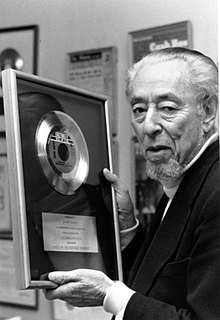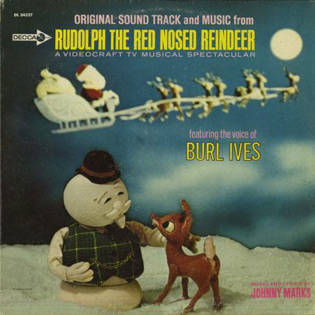
Rudolph the Red-Nosed Reindeer is a fictional reindeer created by Robert Lewis May. Rudolph is usually depicted as the ninth and youngest of Santa Claus's reindeer, using his luminous red nose to lead the reindeer team and guide Santa's sleigh on Christmas Eve. Though he initially receives ridicule for his nose as a fawn, the brightness of his nose is so powerful that it illuminates the team's path through harsh winter weather. Ronald D. Lankford, Jr., described Rudolph's story as "the fantasy story made to order for American children: each child has the need to express and receive approval for his or her individuality and/or special qualities. Rudolph's story embodies the American Dream for the child, written large because of the cultural significance of Christmas."

John David Marks was an American songwriter. He specialized in Christmas songs and wrote many holiday standards, including "Rudolph the Red-Nosed Reindeer", "Rockin' Around the Christmas Tree", "A Holly Jolly Christmas", "Silver and Gold", "I Heard the Bells on Christmas Day", and "Run Rudolph Run".

Rankin/Bass Animated Entertainment was an American production company located in New York, New York, and known for its seasonal television specials, usually done in stop motion animation. Rankin/Bass' stop-motion productions are recognizable by their visual style of doll-like characters with spheroid body parts and ubiquitous powdery snow using an animation technique called "Animagic". Often, traditional cel animation scenes of falling snow would be projected over the action to create the effect of a snowfall.

"'Tis the Fifteenth Season" is the seventh episode of the fifteenth season of the American animated television series The Simpsons, and the seventh Christmas-themed episode overall. It first aired on the Fox network in the United States on December 14, 2003.

Rudolph the Red-Nosed Reindeer is a 1964 Christmas stop motion animated television special produced by Videocraft International, Ltd. and currently distributed by NBCUniversal Television Distribution. It first aired Sunday, December 6, 1964, on the NBC television network in the United States and was sponsored by General Electric under the umbrella title of The General Electric Fantasy Hour. The special was based on the Johnny Marks song "Rudolph the Red-Nosed Reindeer" which was itself based on the poem of the same name written in 1939 by Marks' brother-in-law, Robert L. May. Since 1972, the special has aired on CBS; the network unveiled a high-definition, digitally remastered version of the program in 2005, re-scanned from the original 35 mm film elements.

Rudolph's Shiny New Year is a 1976 American-Japanese Christmas and New Year's stop motion animated television special and a sequel to the 1964 special Rudolph the Red-Nosed Reindeer produced by Rankin/Bass Productions. The special premiered on ABC on December 10, 1976.

In traditional festive legend and popular culture, Santa Claus's reindeer are said to pull a sleigh through the night sky to help Santa Claus deliver gifts to children on Christmas Eve.

Santa Claus is Comin' to Town is a 1970 stop motion Christmas television special produced by Rankin/Bass Productions in New York, New York. The film is narrated by Fred Astaire and starring the voices of Mickey Rooney, Keenan Wynn, Robie Lester, Joan Gardner, and Paul Frees, as well as an assistant song performance by the Westminster Children's Choir. The film tells the story of how Santa Claus and several Claus-related Christmas traditions came to be. It is based on the hit Christmas song "Santa Claus Is Comin' to Town", which was written by J. Fred Coots and Haven Gillespie for Leo Feist, Inc. and introduced on radio by Eddie Cantor in 1934, and the story of Saint Nicholas.

Rudolph the Red-Nosed Reindeer and the Island of Misfit Toys is a 2001 American-Canadian Christmas computer-animated adventure musical film directed by Bill Kowalchuk for GoodTimes Entertainment. It was released on VHS and DVD on October 30, 2001. The film takes place after the events of the original special. The film thus revisits classic characters like Yukon Cornelius, Hermey the Elf and Rudolph, who is now famous in the Arctic tundra.

Rudolph and Frosty's Christmas in July is an American-Japanese Christmas/Independence Day television special produced by Rankin/Bass Productions, featuring characters from the company's holiday specials Rudolph the Red-Nosed Reindeer (1964) and Frosty the Snowman (1969), among others. It was filmed in Japan using the company's trademark "Animagic" stop-motion animation style. The film premiered in the US on November 25, 1979, on ABC.
Robert L. May was the creator of Rudolph the Red-Nosed Reindeer.
Douglas Parker is a Canadian voice actor and animation director. He has been active in the industry since 1985. He has cast, and directed many animated shows and films. He also has voiced characters in several cartoons and anime; he is probably best known for his work in ToddWorld, which was nominated as an outstanding children's animated program. His character Terrorsaur in Beast Wars: Transformers is also well-known, as well as Starscream. Doug also provided the voice of Prince Adam in The New Adventures of He-Man (1990).
"Hooves of Fire" is one of three animated BBC Christmas comedy television specials, filmed using stop motion techniques, and presented in 1999 in aid of Comic Relief.

In English-speaking cultures, a Christmas elf is a diminutive elf that lives with Santa Claus at the North Pole and acts as his helper. Christmas elves are usually depicted as green- or red-clad, with large, pointy ears and wearing pointy hats. They are most often depicted as humanoids, but sometimes as furry mammals with tails. Santa's elves are often said to make the toys in Santa's workshop and take care of his reindeer, among other tasks.

Rudolph the Red-Nosed Reindeer: The Movie is a 1998 American Christmas animated adventure musical film about the character of the same name, who first appeared in a 1939 story by Robert L. May. The film was the first theatrical feature from GoodTimes Entertainment, long known as a home video company. It stars Kathleen Barr as the voice of the titular Rudolph, and also features celebrity talents including John Goodman, Eric Idle, Cathy Weseluck, Whoopi Goldberg, Debbie Reynolds, Richard Simmons and Bob Newhart. The film disappointed at the box-office, recouping only $113,484 of its $10 million budget from its theatrical release.

"Abed's Uncontrollable Christmas" is the eleventh episode of the second season of the American comedy television series Community and the thirty-sixth episode overall. It originally aired on NBC on December 9, 2010. In a break from the show's usual live-action format, the episode is a stop motion Christmas-themed episode.

Rudolph the Red-Nosed Reindeer is a video game based on the television special of the same name. The game was released by Red Wagon Games for both Wii and Nintendo DS on November 9, 2010. However, the developers of the two versions differ: the Wii game was developed by High Voltage Software while the developer of the DS version is American studio Glyphic Entertainment. In this game, the players compete in four different minigames, with each game having its own motion controls. Each minigame has a time limit. Once the time limit is up, the minigame is finished. Up to two players can participate at a time. The game has faced generally negative reviews from sites such as IGN.

Rudolph the Red-Nosed Reindeer is a soundtrack album to the 1964 Rankin/Bass television special of the same name. The original cast recordings from the TV special are supplemented with instrumental versions recorded by the Decca Concert Orchestra. All songs used in the television special were written by Johnny Marks.
Rudolph the Red-Nosed Reindeer is a 1948 animated short film produced and directed by Max Fleischer for Jam Handy based on the 1939 Robert L. May poem of the same name, about a flying reindeer who helps Santa Claus.

Dolly for Sue, better known as just Dolly, is a fictional character that first appears in the 1964 stop motion Christmas TV special Rudolph the Red-Nosed Reindeer. She was one of the many inhabitants of the Island of Misfit Toys, a sanctuary for unwanted toys. Dolly is presumed to be originally voiced by Corinne Conley, and created by Arthur Rankin Jr. and Romeo Muller.















